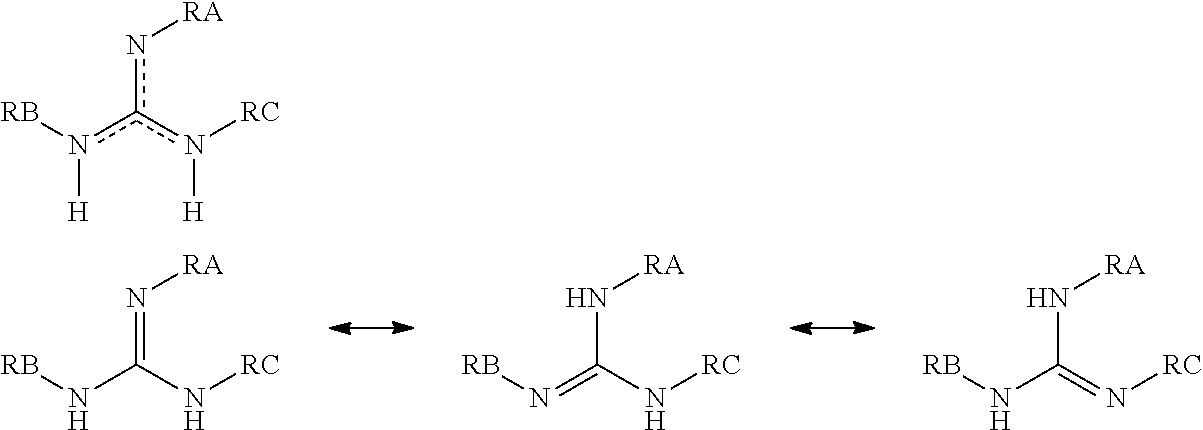Compounds having guanidine groups and containing semi-organic silicon groups
a technology of semi-organic silicon and compound, which is applied in the field of compound having guanidine groups and containing semi-organic silicon groups, can solve the problems of insufficient elucidation of the precise catalytic mechanism of compound, inability to use in the presence of basic components such as amines or basic fillers (e.g. chalk), and generally unacceptable cure times of this duration for the great majority of applications. to achieve the effect of accelerating the curing of compound
- Summary
- Abstract
- Description
- Claims
- Application Information
AI Technical Summary
Benefits of technology
Problems solved by technology
Method used
Image
Examples
example 1
Synthesis Examples
S1 (E6): Preparation of an Aminopropylmethyldimethoxysilane Condensate
[0157]A 250 ml four-necked flask equipped with KPG stirrer, reflux condenser, nitrogen inlet, temperature sensor and heating hood was charged under inert conditions with 100 g (520 mmol) of aminopropylmethyldiethoxysilane (Dynasilan® 1505) and this initial charge was heated to 80° C. Then 18.8 g (1.04 mol) of DI water were added in portions and the mixture was maintained at 75-85° C. for two hours. After the end of hydrolysis, concentration took place on a rotary evaporator at 80° C. and 10-25 mbar. This gave a clear product, with a viscosity much higher than that of the reactant, of the general formula HO—[Si(CH2)3NH2Me]n-OH with n=11-16.
S2 (E1): Preparation of a Linear Aminosiloxane by Equilibration of a Condensate Prepared According to S1 with HMDS
[0158]A 250 ml four-necked flask equipped with KPG stirrer, reflux condenser, nitrogen inlet, temperature sensor and heating hood was charged under ...
example 2
Compositions / Formulations
[0187]In the compositions below, the quantity data in “parts” are based on parts by mass of any unit, and do not add up to 100.
Composition Z1:
[0188]25.9 parts of a polymer which carries alkoxysilyl groups were mixed with 18.1-18.6 parts of diisoundecyl phthalate, 50.5 parts of a precipitated chalk (Socal® U1S2, Solvay) and 0.5 part of the pigment titanium dioxide (Kronos® 2310, Kronos), and this mixture was homogenized by means of a Speedmixer (Speedmixer® FVS 600, Hausschild) (2300 rpm, 4 minutes). Thereafter the mixture was cooled to about 30° C. and 1.4 parts of adhesion promoter (Dynasylan® AMMO, Evonik), 1.1 parts of drying agent (Dynasylan® VTMO, Evonik), 1.5 parts of antioxidant / stabilizer mixture (ratio of Irganox® 1135:Tinuvin® 1130:Tinuvin® 292=1:2:2 ratio) and 0.5-2.0 parts of the curing catalyst were added. The mixture was again homogenized with a Speedmixer (2300 rpm, 1 minute).
Composition Z2:
[0189]25.9 parts of a polymer which carries alkoxysil...
example 3
Use
[0196]All of the completed formulations were transferred to PE cartridges and prior to application were stored at room temperature for at least 24 hours.
Determination of Breaking Stress and Elongation at Break:
[0197]The formulation was knifecoated in a film thickness of 2 mm on a PE surface. The films were stored for 7 days at 23° C. and 50% relative humidity. S2 dumbbell specimens were then punched from the films with the aid of a cutter and a toggle press. The dumbbell specimens thus produced were clamped for testing into a universal testing machine (from Shimadzu), and determinations were made of the breaking stress and elongation at break when the specimens were stretched at a constant velocity (200 mm / min). This determination was made in accordance with DIN 53504.
Determination of Tensile Shear Strength:
[0198]Overlap bonds were produced with the prepared formulation. For these bonds, two stainless steel substrates (V2A, 1.4301) were used. The region of the overlap bond amount...
PUM
| Property | Measurement | Unit |
|---|---|---|
| wt % | aaaaa | aaaaa |
| wt % | aaaaa | aaaaa |
| temperature | aaaaa | aaaaa |
Abstract
Description
Claims
Application Information
 Login to View More
Login to View More - R&D
- Intellectual Property
- Life Sciences
- Materials
- Tech Scout
- Unparalleled Data Quality
- Higher Quality Content
- 60% Fewer Hallucinations
Browse by: Latest US Patents, China's latest patents, Technical Efficacy Thesaurus, Application Domain, Technology Topic, Popular Technical Reports.
© 2025 PatSnap. All rights reserved.Legal|Privacy policy|Modern Slavery Act Transparency Statement|Sitemap|About US| Contact US: help@patsnap.com



